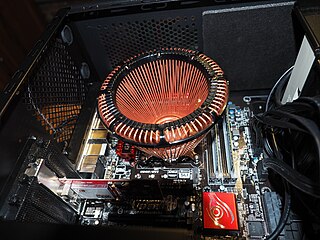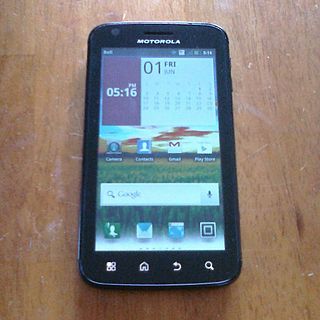
A quiet, silent or fanless PC is a personal computer that makes very little or no noise. Common uses for quiet PCs include video editing, sound mixing and home theater PCs, but noise reduction techniques can also be used to greatly reduce the noise from servers. There is currently no standard definition for a "quiet PC", and the term is generally not used in a business context, but by individuals and the businesses catering to them.

A mobile processor is a microprocessor designed for mobile devices such as laptops, and cell phones.

A graphics processing unit (GPU) is a specialized electronic circuit initially designed to accelerate computer graphics and image processing. After their initial design, GPUs were found to be useful for non-graphic calculations involving embarrassingly parallel problems due to their parallel structure. Other non-graphical uses include the training of neural networks and cryptocurrency mining.

A free and open-source graphics device driver is a software stack which controls computer-graphics hardware and supports graphics-rendering application programming interfaces (APIs) and is released under a free and open-source software license. Graphics device drivers are written for specific hardware to work within a specific operating system kernel and to support a range of APIs used by applications to access the graphics hardware. They may also control output to the display if the display driver is part of the graphics hardware. Most free and open-source graphics device drivers are developed by the Mesa project. The driver is made up of a compiler, a rendering API, and software which manages access to the graphics hardware.

Asus Eee is a family of products by AsusTek Computer Inc. The product family began with the release of the Eee PC subnotebook in 2007; since then, the product family has diversified into a number of PC form factors. According to the company, the name Eee derives from "the three Es," an abbreviation of its advertising slogan for the device: "Easy to learn, Easy to work, Easy to play".

The fit-PC is a small, light, fan-less nettop computer manufactured by the Israeli company CompuLab.

Tegra is a system on a chip (SoC) series developed by Nvidia for mobile devices such as smartphones, personal digital assistants, and mobile Internet devices. The Tegra integrates an ARM architecture central processing unit (CPU), graphics processing unit (GPU), northbridge, southbridge, and memory controller onto one package. Early Tegra SoCs are designed as efficient multimedia processors. The Tegra-line evolved to emphasize performance for gaming and machine learning applications without sacrificing power efficiency, before taking a drastic shift in direction towards platforms that provide vehicular automation with the applied "Nvidia Drive" brand name on reference boards and its semiconductors; and with the "Nvidia Jetson" brand name for boards adequate for AI applications within e.g. robots or drones, and for various smart high level automation purposes.

A mini PC is a small-sized, inexpensive, low-power, legacy-free desktop computer designed for basic tasks such as web browsing, accessing web-based applications, document processing, and audio/video playback.
Nvidia Ion was a product line of Nvidia Corporation intended for motherboards of low-cost portable computers. It used graphics processing units and chipsets intended for small products.

The ARM Cortex-A9 MPCore is a 32-bit multi-core processor that provides up to 4 cache-coherent cores, each implementing the ARM v7 architecture instruction set. It was introduced in 2007.

The ARM Cortex-A15 MPCore is a 32-bit processor core licensed by ARM Holdings implementing the ARMv7-A architecture. It is a multicore processor with out-of-order superscalar pipeline running at up to 2.5 GHz.

The Motorola Atrix 4G is an Android-based smartphone developed by Motorola, introduced at CES 2011 along with the Motorola Xoom, Motorola Droid Bionic, and Motorola Cliq 2 on January 5, 2011. It was made available in the first quarter of 2011.
Project Denver is the codename of a central processing unit designed by Nvidia that implements the ARMv8-A 64/32-bit instruction sets using a combination of simple hardware decoder and software-based binary translation where "Denver's binary translation layer runs in software, at a lower level than the operating system, and stores commonly accessed, already optimized code sequences in a 128 MB cache stored in main memory". Denver is a very wide in-order superscalar pipeline. Its design makes it suitable for integration with other SIPs cores into one die constituting a system on a chip (SoC).

The Asus Eee Pad Transformer TF101 is a 2-in-1 detachable tablet developed by Asus that runs the Android operating system. It is the first tablet in the Asus Transformer Pad series. The Eee Pad Transformer features a 10.1-inch (260 mm) display, an Nvidia Tegra 2 dual-core chip, 1 GB of RAM, and 16 or 32 GB of storage. The tablet initially launched with Android 3.1, nicknamed "Honeycomb", but was updated to support Android 4.0.3.
The Cotton Candy is a very small, fanless single-board computer on a stick, putting the full functions of a personal computer on a device the size of a USB memory stick, manufactured by the Norwegian-based hardware and software for-profit startup company FXI Technologies.
The HP Envy is a line of consumer-oriented high-end laptops, desktop computers and printers manufactured and sold by HP Inc. They started as a high-end version of the HP Pavilion line.

The Nvidia Shield Portable is a handheld game console developed by Nvidia, released on July 31, 2013. It runs on Android Lollipop 5.1, featuring a flip 130mm (5-inch) touchscreen display with 1280×720 resolution. It is similar in shape to an Xbox 360 controller and similar in control setup to a DualShock controller, with two analog joysticks, a D-pad, and other buttons. It is the first device to use Nvidia's Tegra 4 processor. It was originally called Shield or Nvidia Shield, but since the launch of the Shield Tablet, it is called the Shield Portable.
The Utilite is a small, fanless nettop computer manufactured by the Israeli company CompuLab. It was announced in July 2013 and is based upon the Freescale i.MX6 SoC.
Nvidia Drive is a computer platform by Nvidia, aimed at providing autonomous car and driver assistance functionality powered by deep learning. The platform was introduced at the Consumer Electronics Show (CES) in Las Vegas in January 2015. An enhanced version, the Drive PX 2 was introduced at CES a year later, in January 2016.
Nvidia Jetson is a series of embedded computing boards from Nvidia. The Jetson TK1, TX1 and TX2 models all carry a Tegra processor from Nvidia that integrates an ARM architecture central processing unit (CPU). Jetson is a low-power system and is designed for accelerating machine learning applications.













